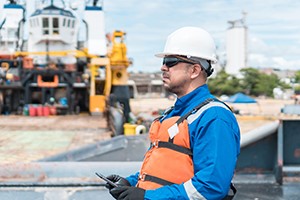Nine Ways to Reduce Fall Hazards and Improve Safety for Marine Workers

Falls into water are a well-known hazard for maritime employees. To help prevent drowning, hypothermia, and other water-related conditions, educate workers, develop plans and procedures, and follow best practices.
The tips below were outlined by the Occupational Safety and Health Administration (OSHA) to help crews who work on or near the water improve safety:
1. Provide employees working near water with personal flotation devices (PFDs) like flotation work vests, anti-exposure work suits, or life preservers. These PFDs need to be U.S. Coast Guard-approved, carefully maintained, regularly inspected, and removed from use whenever damage is detected. When a work or life jacket is being worn, it should fit snugly and remain buckled to keep it from slipping off the employee if they fall into the water
2. Adequately position ring buoys and lines. An ample supply should be visibly marked and easily accessible on docks and cranes
3. Keep recovery devices on hand. At all times, Shepherd’s crooks, rescue cages or baskets, and recovery devices with lines must be ready and nearby to be thrown to fallen workers. Crew members should be aware of the locations of all recovery tools and how to use them
4. Equip basket stretchers with a lifting bridle for stability and safety
5. Reduce falls from height by providing personal protective equipment (PPE). Whenever employees are working longshoring operation heights above 8 feet, fall protection is required by OSHA
6. Properly install, maintain, and position ladders. Both portable and fixed ladders need to be well-marked, clean of plant growth, and placed on shore-side cranes and along the dock in a quantity that ensures they will be accessible if an accident occurs
7. Install guards in high-risk areas. Edges where workers could fall into the water need to be guarded
8. Train employees on the correct procedures for handling a co-worker’s fall. Witnesses should keep the person in sight at all times, throw flotation devices, and attempt to guide the person to a place where they can be pulled out of the water. Emergency responders should be notified immediately and their advice followed to help recover the fallen worker
9. Educate workers on what to do if they fall into the water. Prior to hitting the water, the victim should try to cover their nose and mouth. Once in the water, the individual needs to do their best to remain calm, steady their breathing to a normal rate, keep their neck and head out of the water, and remove objects like tool belts that could weigh them down. Then they should look for floating objects they can grab onto. If nothing is nearby and the water is cold, the person should conserve heat by assuming the fetal position, also known as the heat escape position or H.E.L.P. When there is more than one person in the water, they can all huddle together for warmth
Linesmen, lashers, loggers, and other maritime workers are all at risk of falling into the water. Help reduce these risks and improve safety by developing a person-in-water (PIW) plan that includes training, periodic practice drills, reporting methods, preventive measures, rescue equipment, and emergency procedures.



